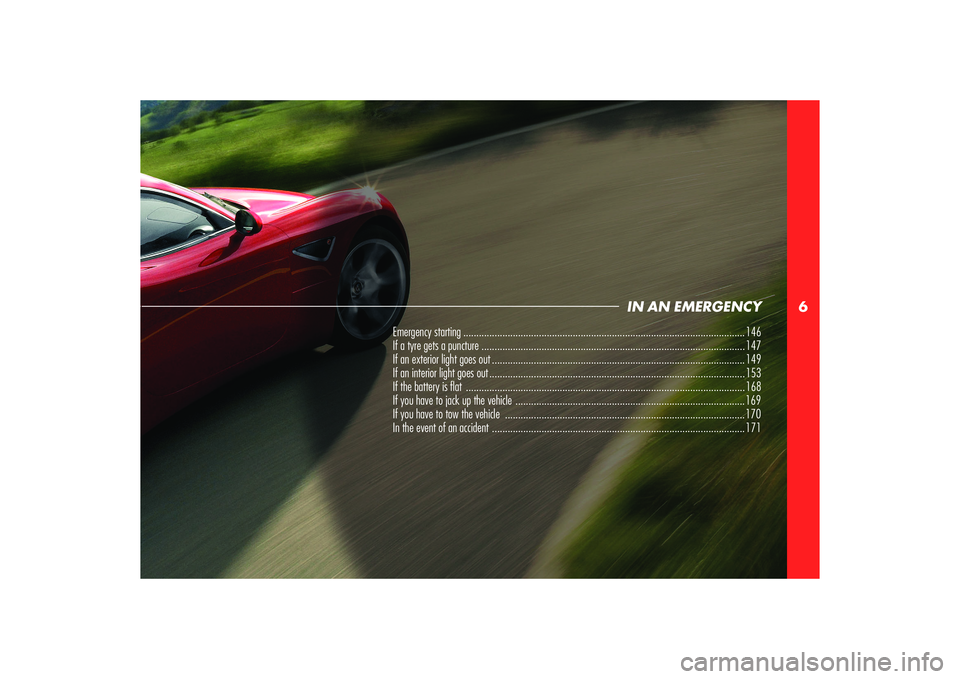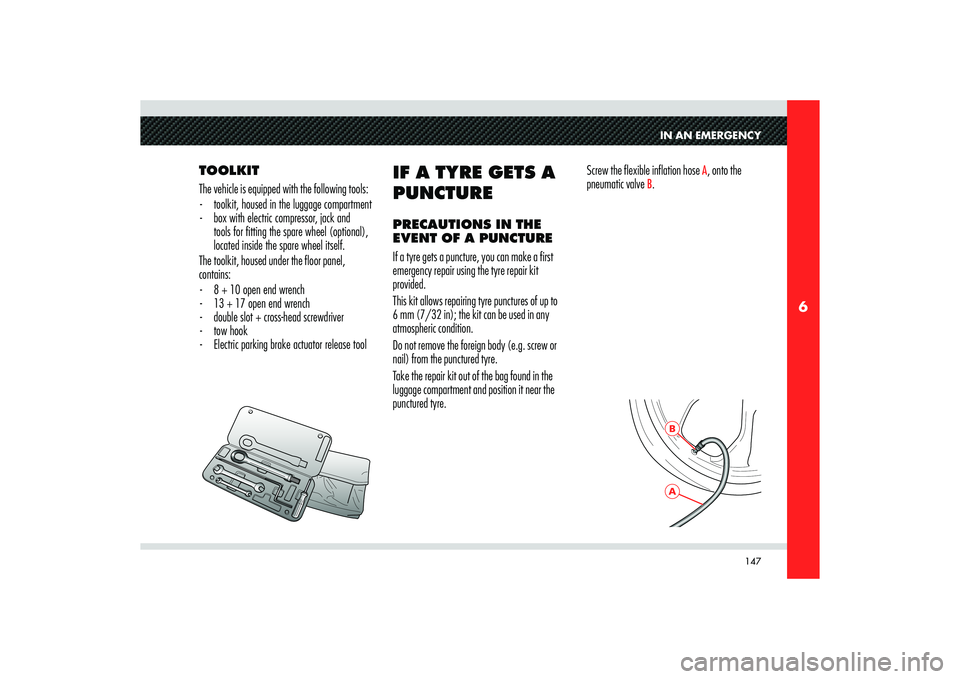Alfa Romeo 8C 2010 Owner handbook (in English)
Manufacturer: ALFA ROMEO, Model Year: 2010, Model line: 8C, Model: Alfa Romeo 8C 2010Pages: 223, PDF Size: 14.35 MB
Page 141 of 223

139
5
A
USING THE VEHICLE
Malfunction indication
In the event of electric parking brake system
failures, the warning light
! on the display
will come on.
Depending on the message displayed, it signals
the following failures of the EPB system:
- Parking brake failure
If the message warning you to go to the
nearest Authorised Service Centre of the
Manufacturer’s Network is displayed,
drive slowly and remember that the electric
parking brake device is not functioning.
- Excessive temperature. If after leaving the engine off (key turned
to STOP) for about 15 minutes without
using the parking brake, the warning
light illuminates again when the engine
is started, slowly drive to an Authorised
Service Centre of the Manufacturer’s
Network. If the brake failure is accompanied by the
message “Mechanical release only”, the
manual emergency deactivation procedure
must be performed to release the parking
brake.
Deactivating the PARK OFF automatic
operation
To deactivate manual operation of the electric
parking brake, with the engine on, press the
button
A on the dashboard. The words PARK OFF
will appear on the display for 5 seconds and then
the page that was active previously will reappear.
To reactivate automatic operation, press the
button A again, the words PARK ON appear on
the display for 5 seconds.
WARNING: In certain conditions, when the
battery voltage is low, the electric parking brake
activation/deactivation system may temporarily
be deactivated for safety reasons. Therefore,
typically during engine starting when the battery
voltage drops, the message PARK OFF may
temporarily appear on the display indicating that
automatic operation is temporarily disabled.
WARNING: In the case of performance
starting, check that the electric parking brake is
disengaged.
Page 142 of 223

140
5
D
- Parking brake system overhaul
The EPB system requires maintenance,
therefore contact an Authorised Service
Centre of the Manufacturer’s Network to
have the system corrected.
CAUTION
In the event of an electric
parking brake failure, contact an
Authorised Service Centre of the
Manufacturer’s Network as soon as
possible.
Emergency disengagement
In the event that the electric parking brake locks
with a total system failure, you need to manually
release the parking brake using the special tool
provided in the toolkit.
Proceed as follows:
- Move the left-hand seat fully forward and
fully tilt the backrest.
- Using a screwdriver remove the cover
D by
prising on its left-hand side.- Insert the special tool in the just uncovered
pipe.
- Turn the handle clockwise until it is
released.
- Remove the tool from the pipe and refi t the
cover.
CAUTION
After each manual emergency
release, the electric parking brake
system will be inefficient until its
operation is corrected by an Authorised
Service Centre of the Manufacturer’s
Network.
Page 143 of 223

141
5
USING THE VEHICLE
TYRESTYRE INFLATION
PRESSURE WHEN COLD
The tyre inflating ratings shown in this manual
must be read as values applicable with cold
tyres.
CAUTION
When winter tyres are fitted,
it is advisable not to exceed a speed
of 220 km/h. Always observe the
regulations in force in the country
where you are driving and follow
the instructions provided by the tyre
manufacturer.
CAUTION
When using the spare wheel
(emergency wheel) do not exceed 80
km/h. Avoid driving at full throttle,
braking sharply and cornering at high
speeds.
WINTER TYRES
These tyres are specially designed for driving on
snow and ice and are fitted to replace the ones
supplied with the vehicle.
CAUTION
Only use winter tyres having
the same dimensions as those provided
with the vehicle or as indicated on
page 186.
The Authorised Service Centres of the
Manufacturer’s Network are available to
provide suggestions as to the types of tyres most
suited to the use foreseen by the Customer.
For the type of tyres to use, inflation pressures
and relative specifications for winter tyres,
carefully follow the indications found in the
section “Capacities and technical specifications”.
The features of these tyres are markedly reduced
in winter when tread depth is less than 4 mm. In
this case, they should be replaced.The specific features of the winter tyres lead to
lower performance under normal environmental
conditions or on long highway trips, compared to
the standard tyres.
Therefore, they should only be fitted for
their intended use, for which they have been
approved.
CAUTION
Fit identical (manufacturer and
tread) tyres on all four wheels, in
order to ensure safe driving, braking
and good manoeuvrability.
CAUTION
Remember that the direction of
tyre rotation should not be reversed.
Page 144 of 223

142
5
SNOW CHAINS
The use of snow chains is subject to the
regulations in force in each country.
Use snow chains of reduced dimensions, with
a maximum protuberance of 9 mm beyond the
tyre tread.
The chains should be fitted only on the driving
wheel tyres (rear wheels).
Check chain tension after driving for a distance of
about 50 meters with the chains fitted.
Deactivation of the system is advised when
chains are fitted on the tyres. Press the ASR-OFF
button - LED on the same button is on. Snow chains: brand/type
KONIG SUPERMAGIC
Rear tyre
285/35 ZR20
WARNING: Before purchasing or using snow
chains, we recommend that you contact
an Authorised Service Centre of the
Manufacturer’s Network for information.
WARNING: Keep a moderate speed, when
chains are fitted on the tyres. Do not exceed
50 km/h. Avoid holes in the road, do not drive
over steps or sidewalks and do not drive on long
sections of roads without snow. This will prevent
damage to the vehicle and the road surface.
USEFUL
ACCESSORIES
TO KEEP IN THE
VEHICLERegardless of applicable legislation, we
recommend that you keep the following in the
vehicle:
- fi rst aid kit containing alcohol-free
disinfectant, sterile gauze pads, gauze rolls,
bandages, etc. (provided with vehicles
manufactured for the German market);
- electric fl ashlight;
- blunt-tipped scissors;
- heavy-duty gloves.
The objects described as well as other essential
objects can be purchased from an Authorised
Service Centre of the Manufacturer’s
Network.
Page 145 of 223

5
Page 146 of 223

6VEHICLE IDENTIFICATION DATA
ACTIVE AND PASSIVE SAFETY
INSTRUMENTS AND CONTROLS
BEFORE YOU DRIVE
USING THE VEHICLE
IN AN EMERGENCY
CAPACITIES AND TECHNICAL SPECIFICATIONS
MAINTENANCE
TABLE OF CONTENTS
Page 147 of 223

6
Emergency starting ............................................................................................................146
If a tyre gets a puncture ..................................................................................................... 147
If an exterior light goes out .................................................................................................149
If an interior light goes out .................................................................................................. 153
If the battery is fl at ........................................................................................................... 168
If you have to jack up the vehicle ........................................................................................ 169
If you have to tow the vehicle ............................................................................................ 170
In the event of an accident ................................................................................................. 171
IN AN EMERGENCY
Page 148 of 223

146
6
EMERGENCY
STARTINGIf the Alfa Romeo CODE fails to deactivate the
engine immobilizer, the CODE
warning light
will illuminate permanently, while the EOBD
warning light will go off after four seconds
to turn on again immediately afterwards: the
engine will not start. To start the engine, it is
necessary to follow the emergency starting
procedure.
WARNING: We recommend that you carefully
read the entire procedure before performing it.
If you make a mistake, turn the ignition key to
STOP and repeat the operations from step 1.1) Read the 5-digit electronic code found on
the CODE CARD.
2) Turn the ignition key to MAR: at this
moment the CODE
and EOBD
warning lights are on.
3) Depress the accelerator pedal and hold
it down. Approximately 8 seconds later,
the EOBD warning light will go off.
Release the accelerator and get ready to
count the number of times the EOBD warning light fl ashes.
4) As soon as the number of fl ashing is equal
to the fi rst digit of your CODE CARD, fully
depress the accelerator pedal and hold it
down until the EOBD warning light
goes off (after approximately 4 seconds).
You can now release the accelerator pedal.
5) The EOBD warning light starts fl ashing
again. As soon as the displayed number of
fl ashing is equal to the second digit of your
CODE CARD, depress the accelerator and
hold it down.
6) Follow the same procedure for the
remaining digits in the code on the CODE
CARD.
7) When the last digit has been entered, keep
the accelerator pedal pressed down. The
EOBD warning light comes on for 4
seconds and then goes off. You can now
release the accelerator pedal.
8) A quick fl ashing of the EOBD warning
light (about 4 seconds) confi rms that
procedure has been carried out correctly.
9) Start the engine by pressing the START
button while holding the brake pedal
depressed.If the EOBD warning light remains on,
turn the key to position STOP and repeat the
procedure from step 1.
This procedure can be repeated an unlimited
number of times.
WARNING: After an emergency staring, you
should contact an Authorised Service Centre of
the Manufacturer’s Network as the emergency
starting procedure will have to be carried out
every time you start the vehicle.
Page 149 of 223

147
6
ABIN AN EMERGENCY
TOOLKIT
The vehicle is equipped with the following tools:
- toolkit, housed in the luggage compartment
- box with electric compressor, jack and
tools for fi tting the spare wheel (optional),
located inside the spare wheel itself.
The toolkit, housed under the floor panel,
contains:
- 8 + 10 open end wrench
- 13 + 17 open end wrench
- double slot + cross-head screwdriver
- tow hook
- Electric parking brake actuator release tool
IF A TYRE GETS A
PUNCTURE PRECAUTIONS IN THE
EVENT OF A PUNCTURE
If a tyre gets a puncture, you can make a first
emergency repair using the tyre repair kit
provided.
This kit allows repairing tyre punctures of up to
6 mm (7/32 in); the kit can be used in any
atmospheric condition.
Do not remove the foreign body (e.g. screw or
nail) from the punctured tyre.
Take the repair kit out of the bag found in the
luggage compartment and position it near the
punctured tyre.Screw the flexible inflation hose
A, onto the
pneumatic valve
B.
Page 150 of 223

148
6
CD
E
F
Remove the cigarette lighter
C, and insert the
connector
D.
Start the engine by pressing the start button (see
page 114).
Press the Fix&Go button
E at position “I”. The
electric compressor will activate and the liquid
with air will inflate the tyre.
A pressure of at least 1.8 bar (26 psi) should
be reached within 20 minutes. If this does not
occur, turn off and remove the Fix&Go kit.
Move the vehicle forward and backward by 10
metres to better distribute the sealant in the tyre.Attach the quick-connector of the compressor
directly on the tyre valve and repeat the inflation
procedure.
If the minimum tyre pressure is not reached,
do not start the vehicle. Contact an Authorised
Service Centre of the Manufacturer’s
Network.
When the correct pressure has been reached,
move the vehicle forward and backward to
evenly distribute the sealant in the tyre.
After 10 minutes, stop and check the tyre
pressure. If the pressure is below 1.3 bar
(19 psi), do not drive the vehicle. The tyre is
excessively damaged. Contact an Authorised Service Centre of the
Manufacturer’s Network.
If the pressure is equal to or greater than 1.3
bar (19 psi), repeat the inflation procedure until
reaching the adequate tyre pressure and resume
driving.
Remove the warning label
F from the bottle and
position it on the dashboard as a reminder to
the driver that the tyre has been treated with
automatic Fix&Go.